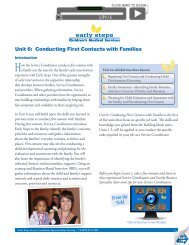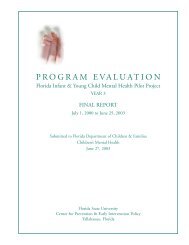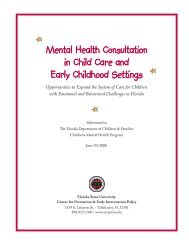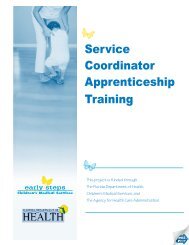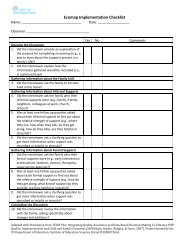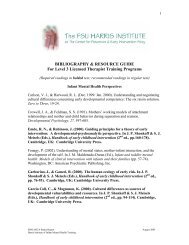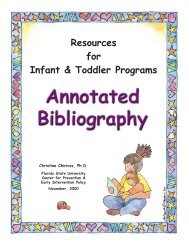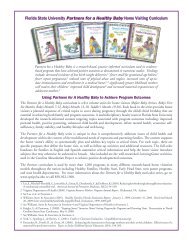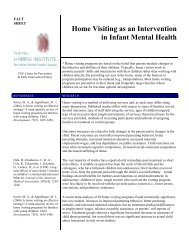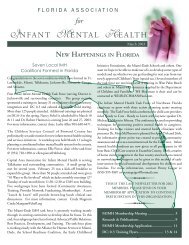Improved Child DevelopmentThe Chicago Public Schools’ Cradle <strong>to</strong> Classroom program used <strong>Partners</strong> <strong>for</strong> a <strong>Healthy</strong> <strong>Baby</strong> and LearningGames <strong>to</strong>improve developmental outcomes <strong>for</strong> children of teen mothers. <strong>Program</strong> outcomes include:• When the Ages and Stages Questionnaire (ASQ) was administered at 3 years of age, 59% of the comparison group andonly 9% of the intervention group were classified at increased risk and of special concern.• Mean scores on the ASQ <strong>for</strong> children who received the intervention were well within the normal range, whereas themean scores <strong>for</strong> the comparison children were below the cu<strong>to</strong>ff points between 4 and 36 months.—York, V., Sparling, J., & Ramey, C. (2001). Cradle <strong>to</strong> Classroom Evaluation. Unpublished manuscript.<strong>Partners</strong> <strong>for</strong> a <strong>Healthy</strong> <strong>Baby</strong> includes LearningGames, the well-researched early childhood curriculum developed <strong>for</strong> theCarolina Abecedarian Project. Positive benefits <strong>for</strong> the children who received the Abecedarian intervention include:• higher IQ detected as early as 18 months of age• improved school per<strong>for</strong>mance in reading and math• reduced retention in grade• higher likelihood of high school graduation and college attendance• fewer teen pregnancies—Ramey, C. T., & Campbell, F. A. (1984). Preventive education <strong>for</strong> at-risk children: Cognitive consequences of the Carolina AbecedarianProject. American Journal of Mental Deficiency, 88, 515-523.—Martin, S. L., Ramey, C. T., & Ramey, S. L. (1990). The prevention of intellectual impairment in children of impoverished families: Findingsof a randomized trial of educational daycare. American Journal of Public Health, 80, 844-847.—Burchinal, M. R., Campbell, F. A., Bryant, D.M., Wasik, B. H., & Ramey, C. T. (1997). Early intervention and mediating processes incognitive per<strong>for</strong>mance of children of low-income African American families. Child Development, 68, 935-954.—Campbell, F. A., Ramey, C. T., Pungello, E., Sparling, J., & Miller-Johnson, S. (2002). Early childhood education: Young adult outcomesfrom the Abecedarian Project. Applied Developmental Science, 6(1), 42-57.• A <strong>to</strong>tal of 11,889 developmental screenings were completed on children enrolled in the Tennessee HUGS programand of these 1,740 (14%) indicated developmental delays.—Tennessee Department of Health, Maternal and Child Health. (2011). Tennessee Home Visiting <strong>Program</strong>s Annual Report: July 1, 2009–June 30,2010. Nashville, TN: Author. Retrieved from http://health.state.tn.us/statistics/PdfFiles/Home_Visiting_<strong>Program</strong>s_Annual_Report_2010.pdfCore Element 2: Con<strong>for</strong>m <strong>to</strong> a clear consistent home visitation model that has been in existence <strong>for</strong> at least threeyears and is research-based; grounded in relevant empirically-based knowledge; linked <strong>to</strong> program determined outcomes;associated with a national organization or institution of higher education that has comprehensive home visitationprogram standards that ensure high quality service delivery and continuous program quality improvement; and hasdemonstrated significant positive outcomes.Core Element 3: Serves pregnant women and/or parent/s or other primary caregivers and their children under the ageof entry in<strong>to</strong> kindergarten who are low income or at risk of poor outcomes.With respect <strong>to</strong> Core Elements 2 and 3, the <strong>Partners</strong> <strong>for</strong> a <strong>Healthy</strong> <strong>Baby</strong> series is unique in that, <strong>to</strong> our knowledge, itis the only comprehensive curriculum that addresses issues of child health and development within the context of themultifaceted needs of families. Developed by a multidisciplinary faculty at Florida State University and piloted at theFSU Early Head Start program, the series provides the home visi<strong>to</strong>r with a planned sequence of critical <strong>to</strong>pics that areessential in achieving both family and program outcomes.The <strong>Partners</strong> curricular series is used by more than 3,700 programs in a variety of research-based home visitation modelsthroughout the nation including <strong>Healthy</strong> Families, <strong>Healthy</strong> Start, and Early Head Start—the nation’s premier program<strong>for</strong> low income infants and <strong>to</strong>ddlers. These programs all have national affiliations, long his<strong>to</strong>ries of effectiveness, andthey serve pregnant and parenting families and their young children who are low income or at risk <strong>for</strong> poor outcomes.The <strong>Partners</strong> curriculum helps <strong>Healthy</strong> Start programs achieve better birth outcomes by addressing <strong>to</strong>pics such as:prenatal care, diet and exercise, smoking cessation, healthy lifestyles, the physical and emotional changes of pregnancy,bonding and attachment, and the importance of spacing pregnancies. The <strong>Partners</strong> curriculum supports <strong>Healthy</strong> Familiesprograms ef<strong>for</strong>ts in child abuse prevention and family stability through its focus on positive parenting, child safety, familyrelationships, healthy birth outcomes, infant mental health, and child development. The <strong>Partners</strong> curriculum supportsEarly Head Start’s goals of family empowerment and child development through <strong>to</strong>pics on economic self-sufficiency,4 Florida State University <strong>Partners</strong> <strong>for</strong> a <strong>Healthy</strong> <strong>Baby</strong> • www.cpeip.fsu.edu • September 2011
fatherhood, nutrition, parenting, and developmental skills. The <strong>Partners</strong> <strong>for</strong> a <strong>Healthy</strong> <strong>Baby</strong> series is also widely used in teenparent programs, state health departments, and other community-based home visiting programs that serve low incomeor at risk families. (See below <strong>for</strong> descriptions of programs using the <strong>Partners</strong> curriculum and their reported outcomes.)The <strong>Partners</strong> curriculum is sometimes used in conjunction with the Born <strong>to</strong> Learn curriculum in programs following theParents as Teachers model. Some agencies implementing the Nurse Family <strong>Partners</strong>hip model have reported also usingthe <strong>Partners</strong> curriculum.Core Element 4: Delivered by nurses, social workers, child development specialists, or other well-trained and competentstaff, as demonstrated by education or training and the provision of ongoing and specific training and supervision in themodel of service being delivered.The <strong>Partners</strong> curriculum is designed <strong>for</strong> use by both professional home visi<strong>to</strong>rs—including nurses, social workers, childdevelopment specialists—and well-trained paraprofessionals in home based programs. On-going training is essential <strong>to</strong>the effective use of the curriculum. Intensive training on the <strong>Partners</strong> curriculum series is offered in Florida <strong>for</strong> programsusing the curriculum. On-site training is also available. The <strong>Baby</strong>’s First Year Training Supplement CD-ROM is a selfguidedoverview of <strong>Baby</strong>’s First Six Months and <strong>Baby</strong>’s Months 7-12.<strong>Program</strong>s <strong>Using</strong> the <strong>Partners</strong> Curriculum: <strong>Program</strong> Description & <strong>Outcomes</strong><strong>Healthy</strong> Families New York (HFNY) has used the <strong>Partners</strong> <strong>for</strong> a <strong>Healthy</strong> <strong>Baby</strong> curricular series since 1999. HFNY isa home visitation program <strong>for</strong> mothers at risk <strong>for</strong> developing abusive or neglectful behaviors <strong>to</strong>ward their children.Goals are <strong>to</strong> promote positive parenting, prevent child abuse and/or neglect, support prenatal care and child healthand development, and improve parental self-sufficiency. A three-year evaluation of the program was conducted by theBureau of Evaluation and Research in collaboration with the University at Albany. Pregnant women and adolescentswere randomly assigned <strong>to</strong> either an intervention group receiving bi-weekly home visits (n=236) or <strong>to</strong> a control group(n=265). Home visi<strong>to</strong>rs encouraged healthy prenatal behavior, offered social support and provided linkage <strong>to</strong> medicaland other community services. The risk of delivering a low birth weight (LBW) baby was significantly lower <strong>for</strong> theHFNY group (5.1%) than <strong>for</strong> the control group (9.8%). HFNY mothers also delivered fewer small <strong>for</strong> gestational age(SGA) babies than control mothers (8.8% vs. 11.6%). In summary, the home visited mothers were approximately halfas likely as control mothers <strong>to</strong> deliver LBW babies. Mothers offered home visitation services earlier in their pregnanciesexperienced even greater reductions in the number of LBW deliveries, suggesting the benefit of engaging vulnerableexpectant women early in pregnancy. In addition <strong>to</strong> the study of birth outcomes, evalua<strong>to</strong>rs assessed maternal/childinteractions. By the child’s third year of life, HFNY mothers were more likely <strong>to</strong> use positive parenting strategies (e.g.,cognitive stimulation, attentive and responsive <strong>to</strong> affective cues) than mothers in the control group.—Lee, E., Mitchell-Herzfeld, S., Lowenfels, A., Green, R., Dorabawila, V., & DuMont, K. (2009). Reducing low birth weight through homevisitation: A randomized controlled trial. American Journal of Preventive Medicine, 36(2), 154-160.—DuMont, K., Rodriguez, M., Mitchell-Herzfeld, S., Walden, N., Kirkland, K., Greene, R., Lee, E. (2008). Effects of <strong>Healthy</strong> Families New Yorkon maternal behaviors: Observational assessments of positive and negative parenting. Rensselaer, New York: New York State Office of Children andFamily Services.<strong>Healthy</strong> Families Florida (HFF) is one of the largest home visiting programs using the evidence-based <strong>Healthy</strong> FamiliesAmerica model. Well trained paraprofessional family support workers provide home visiting services, beginning prenatallyor at the birth of a baby, <strong>to</strong> families living in geographically targeted areas who have been assessed as experiencing stressfullife situations. These visits may continue <strong>for</strong> up <strong>to</strong> five years. Goals are <strong>to</strong> prevent child abuse, promote positive parent/child relationships and healthy child development, and enhance family functioning and problem solving skills. A fiveyearindependent evaluation was conducted between 1999 and 2003, during which time 22,708 families were servedand the <strong>Partners</strong> <strong>for</strong> a <strong>Healthy</strong> <strong>Baby</strong> series was the primary curriculum. The evaluation, which used a quasi-experimentaldesign, found that HFF children were 3.7 times less likely than the comparison group <strong>to</strong> experience child maltreatmentand more likely <strong>to</strong> be up-<strong>to</strong>-date with their immunizations (92% compared <strong>to</strong> 77% statewide) and have a medical home(97%). There was 58% less child abuse in families who received 3 or more years of service or completed HFF compared<strong>to</strong> families who received less than 3 months of services or no services. HFF mothers were 1.5 times more likely <strong>to</strong> beemployed and, when involved in the program 3 years or more, were significantly more likely <strong>to</strong> read <strong>to</strong> their child thanmothers in the comparison group. An impressive 92% of HFF mothers delayed subsequent pregnancies.—Williams, Stern & Associates. (2005). <strong>Healthy</strong> Families Florida Evaluation Report: January 1, 1999–December 31, 2003. Retrieved March 26,2009 from www.healthyfamiliesfla.org/pdfs/Final_Evaluation_1999-2003.pdfFlorida State University <strong>Partners</strong> <strong>for</strong> a <strong>Healthy</strong> <strong>Baby</strong> • www.cpeip.fsu.edu • September 2011 5




